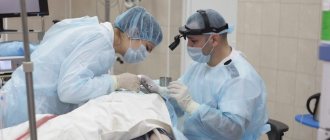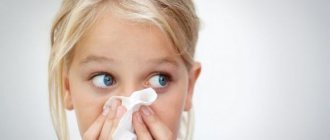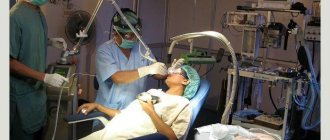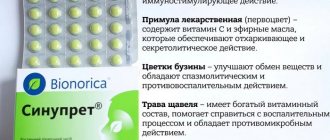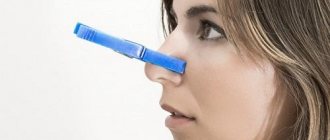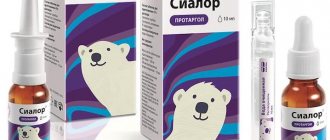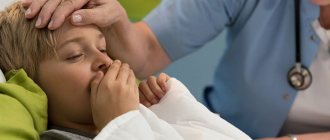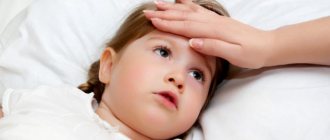What are adenoids and adenoiditis
Adenoids and allergies are interrelated concepts. In the first case, we are talking about hypertrophied tonsils of the nasopharynx, which protect the body from the penetration of pathogenic flora. This is a significant component of local immunity, which is so important not to lose.
Children aged 3-8 years are more likely to experience the problem of inflamed tonsils. When an external or internal stimulus penetrates, they not only increase in size, but also change their usual structure. Inflammation of lymphoid tissue of various etiologies is called adenoiditis of various origins .
Allergic adenoiditis
Chronic inflammation of the nasopharyngeal tonsils under the influence of an allergen is called allergic adenoiditis . The disease often progresses in preschool children, negatively affects the immune system, and is prone to chronicity and relapse. The trigger attacks the airways, which were protected by healthy tonsils.
If the adenoids have enlarged due to allergies and have not returned to their original position, the health problem gets worse. You cannot do without an individual consultation with an otolaryngologist. Adenoids and allergies are more common ; this disease is unusual for adults (isolated cases are known).
Causes of adenoids
To solve a health problem, first of all, it is important to understand why adenoiditis of allergic origin . The main thing is to correctly identify the provoking factor. Allergens that cause the growth of adenoids are household dust, animal hair, pollen, bird fluff and feathers, chemicals, etc.
With short-term exposure to an allergen, the adenoids in children return to their original position. Otherwise, the lymphoid tissue continues to grow pathologically and become coarse, breathing is disrupted, the child’s general well-being dynamically worsens, and sleep is disturbed. There is a high probability of morbidity with weakened immunity, long-term use of medications, and hypersensitivity reactions of the body.
Important: without determining the nature of the provoking factor, allergic adenoiditis in children is difficult to treat conservatively. Due to the patient’s ignorance and the doctor’s incompetence, the disease soon becomes chronic.
Symptoms of allergic adenoiditis
If the adenoids are enlarged due to allergies , breathing is the first to be affected. nasal congestion which interferes with sleep and makes him nervous and irritable. Breathing through the mouth becomes more frequent and intermittent. The clinical picture is not limited to a prolonged runny nose the symptoms of allergic adenoiditis in children only worsen. Possible complaints:
- itching and burning in the nose;
- chronic rhinitis;
- lacrimation, redness of the mucous membranes of the eyes;
- mucous discharge from the nose (sputum);
- feeling of sand in the eyes;
- change in voice timbre;
- swelling and soreness in the oropharynx;
- enlarged cervical lymph nodes;
- snore ;
- headache;
- increased body temperature;
- lack of appetite;
- decreased concentration;
- general weakness.
At a consultation, a specialist can immediately assume allergic adenoiditis in children. Symptoms of inflammation when examining inflamed tonsils:
- severe swelling, hyperemia of the nasopharynx;
- loose in structure, enlarged tonsils.
A visual examination of the patient is not enough; a number of diagnostic measures are carried out in the hospital. Allergic adenoids can masquerade as other viral and infectious diseases, for example, the classic cold or acute tonsillitis. Therefore, the approach to the problem is complex.
What are the symptoms of adenoids?
You can suspect that the baby has an overgrowth of the tissues of the nasopharyngeal tonsil - adenoids, based on the following characteristic symptoms:
- nasal breathing is difficult, and there is no mucous or purulent discharge, which is typical for rhinitis - in children, a prolonged runny nose with adenoids is the main complaint;
- the baby is forced to sleep with his mouth open, and even snores from time to time;
- The baby's sleep becomes restless, he often wakes up, gets scared, cries;
- sinking of the root of the tongue during such sleep leads to attacks of suffocation, which further aggravates the situation;
- the difficulty of removing pathological exudate out due to the blocking of the nasal passages with hypertrophied tissue, provokes a cough with adenoids in children - mucus flowing down the back wall of the throat is irritating, the child constantly feels the urge to cough.
The long course of the disease leads to many complications - from the child’s absent-mindedness and inattention during classes in kindergarten or school, to disruption of the normal process of development of the facial skeleton. Therefore, it is so important to seek medical help on time. Temperature after adenoid removal is no less dangerous than before surgery.
Diagnostics
If adenoids are suspected from allergies, the symptoms are voiced to collect medical history data. The treatment is provided by an otolaryngologist, an allergist, and a pediatrician. Allergies and adenoids in children are determined clinically:
- Endoscopy. An accurate and safe method for examining the tonsils with a special device - an endoscope.
- Radiography. The method is rarely used due to the need to irradiate the child’s body.
- CT scan. Prescribed for a complicated form of the disease to assess the condition of the tonsils.
If allergic adenoiditis is suspected in children, symptoms and treatment must be associated with the body's response to the provoking factor. To do this, take a blood test. If the result is positive, the concentration of immunoglobulin E and eosinophils in the biological fluid increases pathologically.
What is the temperature for adenoids
In the acute stage, adenoiditis in a child is accompanied by a fairly high temperature. Often hyperthermia can reach 39 degrees, and sometimes more than 40 - it all depends on the presence of concomitant diseases. You should not hope that the disease will go away on its own - the inflammatory process remains in the body and simply enters the chronic stage, thereby causing discomfort to the patient.
If the acute process is ignored, the symptoms subside and a chronic course begins. During a “quiet” course, outbreaks of exacerbation occur - then the temperature rises to 39 - 40 degrees. The rest of the time, low-grade hyperthermia is recorded. Usually during this period the child’s temperature is 37, sometimes 37.5. Such a slight increase causes much more problems than an acute occurrence.
What temperature does adenoids cause?
Treatment
When asked how to treat allergic adenoids , doctors have one answer - conservatively. The main thing is to correctly identify the allergen, stop contact with it, and correctly select antihistamines from one of the three generations.
Another question, why adenoids cannot be operated on for allergies , also does not go unnoticed. Doctors explain the irrelevance of the operation by the inability of surgical intervention to stop the body’s allergic reaction and stop exposure to the allergen.
If allergic adenoids in children have worsened, treatment is complex and includes the following measures:
- course of medication;
- nasal rinsing and inhalation;
- a course of physiotherapeutic procedures;
- vitamin therapy.
With timely treatment, positive dynamics are noticeable after 2-3 days, while complete recovery occurs after 7-10 days (in the absence of complications).
Medications
When adenoids grow, a medicinal course of drugs from several pharmacological groups is recommended. Among them:
- antihistamines: Suprastin, Loratadine, Diazolin, Tavegil;
- homeopathy: Calcium phosphoricum, thuja oil;
- vasoconstrictors: Vibrocil, Sanorin, Kromhexal (nasal drops);
- solutions with sea water: Humer, Aqualor, Aqua Maris;
- enterosorbents: Enterosgel, Polysorb;
- immunomodulators: Amiksin, Immunal, Cycloferon;
- vitamin complexes: Duovit, Alphabet, etc.
When diagnosed with allergic adenoiditis in children, treatment includes taking several groups of medications at once. The main thing is to eliminate hypersensitivity reactions in the body and the risk of drug interactions, and not to self-medicate.
Physiotherapeutic methods
Allergic adenoids can be eliminated with a course of physiotherapy. Doctors recommend treatment for 10-14 days, not stopping home/inpatient procedures at the first improvement. Effective physiotherapeutic methods for manifestations of adenoiditis:
- Inhalations. Home and hospital procedures to improve nasal breathing act locally.
- Washing. Therapeutic solutions wash away the accumulation of mucus in the nasal passages and improve breathing through the nose.
- Electrophoresis. Under the influence of microcurrents, medications penetrate deep into the lymphoid tissues and act faster.
- Laser therapy. Under the influence of heat flow, blood circulation in the nasal sinuses improves, phlegm is removed, and breathing becomes easier.
- Ultraviolet. This method can not only eliminate swelling of the nasal mucosa, but also destroy pathogenic flora (does not apply to an allergic reaction).
- Magnetotherapy. Magnetic currents stimulate cellular metabolism, relieve pain, relieve inflammation, and regenerate injured tissue.
- Darsonvalization. Pulsed microcurrents act on inflamed tonsils, relieve swelling and pain, and improve the permeability of lymphoid tissue.
If you combine medications and a course of physical therapy, allergic adenoids shrink and disappear after 7-10 days. It is advisable to maintain the child’s condition, otherwise the next time there is contact with allergens , the disease will worsen again.
Surgical methods
Doctors do not recommend surgical removal of allergic adenoids for several reasons:
- the child is deprived of natural immunity;
- tracheobronchitis or bronchial asthma may worsen;
- possible reappearance of inflamed adenoids;
- repeat surgery may be required;
- the effectiveness of the treatment method is in great doubt.
If the attending physician suggests surgery, whether to agree or not is the final word for the parents. Medical indications for surgery:
- colds have become more frequent;
- advanced form of the disease with deformed tonsils.
In case of an acute inflammatory process, surgery is not performed; the otolaryngologist monitors the small patient in the hospital and prescribes drug therapy with a course of physiotherapy.
Traditional methods
Since adenoids and allergies are treated conservatively, it is recommended to additionally use alternative medicine methods. Folk remedies enhance the effect of medications and become an important component of physiotherapeutic procedures. Against allergy symptoms and for treatment, use the following health recipes:
- Dissolve 1 teaspoon sea salt or 1 tablespoon table salt in 1 glass of water, stir until the crystals dissolve. Buy a pear and use the solution to rinse your nose 2-3 times a day. Course – 7-10 days.
- Brew 1 tablespoon of chamomile in 1 glass of boiling water. Infuse, strain, use the solution to gargle. Using the same recipe, prepare a decoction of eucalyptus leaves, oak bark, and calendula.
- Grind the horsetail. After 4 tbsp. l. raw materials, brew 500 ml of boiling water, simmer over moderate heat for 5-10 minutes. Leave for an hour, strain, use the solution to rinse the nasal passages 2-3 times a day. The course of treatment is 7-10 days.
- Dissolve freshly squeezed Kalanchoe juice with boiled water in a ratio of 1 to 3. Rinse your nose with the resulting solution 4 times a day. Continue treatment until complete recovery.
When choosing an effective folk remedy, avoid an allergic reaction of the child’s body to the components of medicinal preparations. If there is no improvement within 3-5 days, consult a doctor unscheduled and change your health prescription.
What not to do at high temperatures
It often happens that parents, in fear for the child’s life, begin to lower the temperature in every possible way, which is a serious mistake. Many “adult” drugs can significantly harm the baby and cause an even more complex clinical picture. The first thing you need to do is call a pediatrician at home, and while he is traveling, ensure peace and access to fresh drink. If you have adenoids, you should not feed your baby aggressive antipyretics. Until a definitive diagnosis has been established, the patient is prohibited from taking any medications - no injections, no tablets, no syrups, no decoctions.
Among other things, if you give a small patient antibiotics or other strong drugs before the doctors arrive, you can not only cause harm, but also complicate subsequent diagnosis. You cannot decide on your own to take any medications, even if the parents are absolutely sure that the adenoids are inflamed. Adenoiditis can be the cause of completely different diseases that need to be treated first. You cannot give milk to a patient, because if there is an inflammatory process in the body, it will quickly curdle, causing nausea and vomiting. If vomiting begins, the weakened body quickly begins to lose fluid and becomes dehydrated, thus running the risk of intoxication and worsening the condition.
Under no circumstances should you wrap the patient up, apply compresses, or warm the throat, ears or nose. Inhalations are prohibited - this can provoke more severe inflammation. You should also not try to lower the temperature in the room, apply ice to the sore area, or perform other manipulations yourself. If the patient’s condition worsens, it is better to call the doctor and follow all his recommendations over the phone before the ambulance arrives.
Prevention
To exclude allergic adenoiditis, observe 2 basic conditions: strengthen the immune system, promptly neutralize the effect of allergens that cause deformation of the tonsil tissue.
A set of preventive measures:
- Ventilate the room regularly and maintain acceptable air humidity.
- Increase your child's physical activity and spend time with him in the fresh air more often.
- Brush your teeth every day, rinse your nose in case of various contaminants from the street.
- Temper your baby regularly.
- Treat viral and colds in a timely manner.
- Limit contact with sick children.
- If possible, take your child to the sea during the summer season.
You should not think about how to treat the disease; it is better to prevent it in a timely manner, especially since it is not difficult to do. Adenoids from allergies are not a fatal disease, but unpleasant. At the first signs of illness, take your sick child to your local pediatrician, and he will tell you how to proceed and where to go. Don't trigger alarm symptoms.


